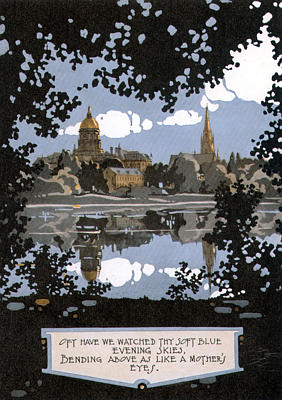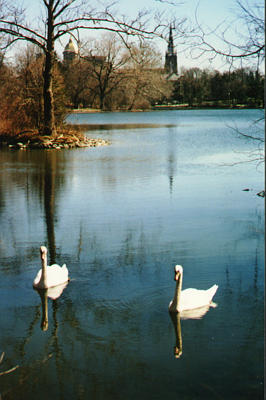
Notre Dame's Grotto / by Dorothy V. Corson


Two Deaths Associated With The Grotto
If there were two or three deaths associated with the Grotto, it would be recorded in the 1896 newspapers. And if the Grotto had collapsed it might also be mentioned. Four months of newspapers, from May through September, would cover the time the Grotto was being built. There were many unusual stories, but none of the deaths recorded were associated with the Grotto.
What the world was like almost one hundred years ago, and what the weather was like, added more details to the Grotto story. The temperature reached 102 degrees during the time the Grotto was being built. An unusually hot summer spawned violent thunderstorms. A horrendous tornado in St. Louis left hundreds of people dead. The most common accidents recorded were with runaway horses.
The first mention of the Grotto appeared under the heading, "New Grotto Of Lourdes." It was a brief announcement. "The contract has been let for a new Grotto of Lourdes at Notre Dame to cost about $2,500. It will be constructed entirely of stone."(146)
There was no other mention of the Grotto while it was being built in any of the four local newspapers. Only a brief mention was made of its dedication in August. However, there was a reference to a Michael Presho who had been injured while unloading a wagon of stone. It happened at Notre Dame, so it had to be at the Grotto:
Michael Presho was engaged in hauling stone to Notre Dame this morning. A large stone had been taken from the front end of the wagon, allowing another large one to remain in the rear. This overbalanced and threw Presho at least 10 or 12 feet into the air. He fell, striking on the wagon gearing and sustained internal injuries. It was thought he was injured fatally, but his physician has hopes of his recovery.(147)
The South Bend Tribune also reported two drownings in the St. Joseph Lake on the Notre Dame campus during the month of June. They occurred within two weeks of each other. The brickmason's son's words took on a new meaning. "Two people died while the Grotto was being built" didn't have to mean at the Grotto itself in the process of building it. If two people had drowned nearby in the St. Joseph Lake, someone working on the Grotto would have said, "two people died while the Grotto was being built." In this case, it would mean in close proximity to their work on the Grotto.
There were a possible three people in the brickmason's story. He had said two or three, he wasn't sure. Perhaps, the third man, Michael Presho, who was injured at the Grotto, had not survived. This also might explain why there was some doubt about a third death. Perhaps these two masons who worked at the Grotto had not known the outcome of what must have appeared to be a fatal injury.
The city directory for the subsequent years revealed that Michael Presho had survived what had been described as a serious injury. He was listed as a teamster, a name given to men who drove teams of horses in 1896.
Although nothing in the records verified that these two Kowalski men were masons who worked on the Grotto, their knowledge of the deaths was proof positive they had been there. No one else would have had this information to pass on.
One of the two drownings was Brother Michael Desmaison, an elderly basket weaver who lived on campus. He had gone to the lake to collect reeds for basket making and had somehow stumbled, fallen in, and drowned. He was found the next day in 18 inches of water by a newsboy walking along the lake.(148)

The research on these drownings led to the discovery of another interesting item of information. In the early days, St. Mary's lake was called "Blue Lake." A descendant of Timothy Howard, author of A Brief History of the University of Notre Dame du Lac, about Notre Dame's first fifty years, verified this little known fact. He then added another. The St. Joseph Lake was known as "Mud Lake." He wasn't sure how they got their names. In the case of St. Mary's Lake, he thought it might have referred to the beauty of the lake or because it was the color of blue associated with Our Lady. St. Joseph Lake, he said, could have been dubbed "Mud Lake," by the students because it was the swimming lake and had a muddy bottom.
The second drowning, about two weeks later, was a 19-year-old seminarian from Ireland, Lawrence Parnell. He had been swimming in St. Mary's Lake alone. It was believed he had a heart attack or had been entangled in the weeds. In one newspaper, this interesting mention was added to Lawrence Parnell's obituary. "He had a sister who was a Holy Cross nun, Sister Othelia, at St. Mary's."(149)
An elderly Sister at St. Mary's Convent remembered a relative and supplied her address. A niece, Sister Eutropia, was still living at 92, at St. Catherine by the Sea in Ventura, California. A letter from her provided another glimpse of what was happening on the campus, during the summer of 1896, when the Grotto was being built.
I was only in the mind of God in 1896 when the sudden and sad death of my uncle, Lawrence Parnell, occurred. I met Sister Othelia for the first time in 1920 in New York after crossing the ocean en route to the Novitiate at St. Mary's. The visit was short but we did full justice to our get together and that same summer we visited Lawrence's grave . . . talked of their rewarding summer in 1896, and their fond goodbyes.
After their visit, she returned to Eureka, Utah, and the sad news reached her a short time later. She was not able to return for the funeral. Thank God, He does heal our sorrows with the passage of time. She was a lovely lady, my aunt, and a good friend. She died in 1952.(150)
A visit to his grave in the seminarian section of the Holy Cross Community Cemetery was like reaching back in time. These poetic words from an old Scholastic speak of those bygone days:
The flowers of the heart that blossomed then, have never fully faded away. They are still there to be revived and freshened by the dews of memory and the tears of grief.
It is difficult to even begin to fathom the number of feet that have trod the paths from here to there; the wealth of memories attached to every corner of the campus; all the human history that has left its imprint on the University grounds in more than one hundred and fifty years.